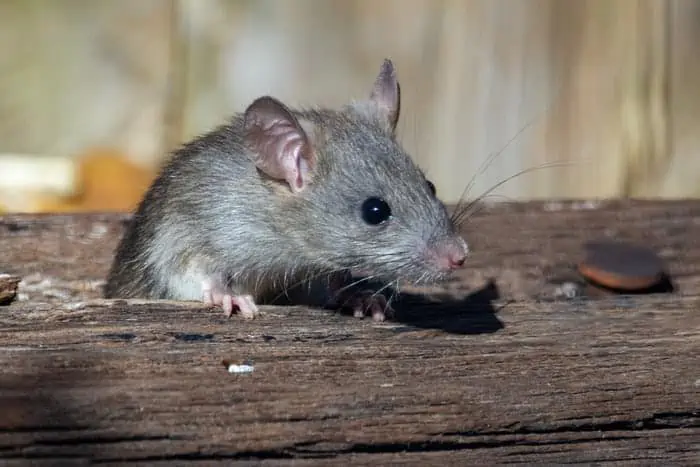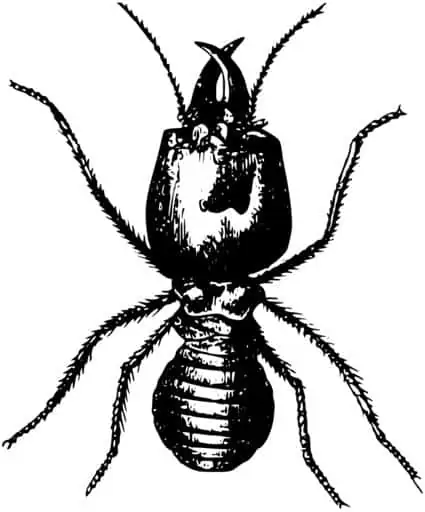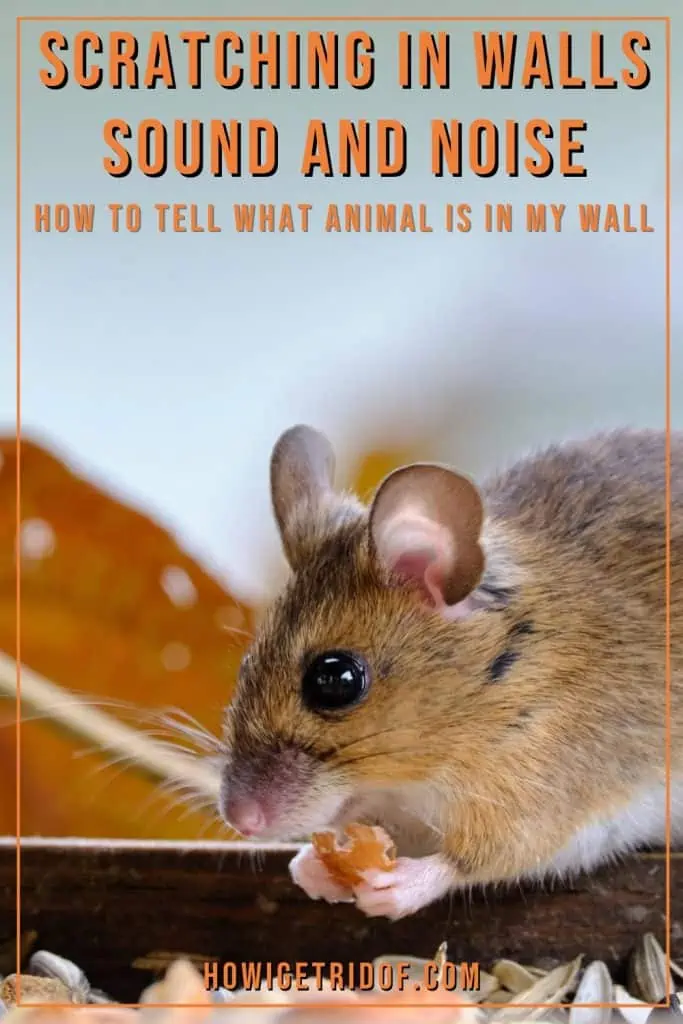Scratching in walls is quite common, especially considering there are so many different types of pests that can lead to this frustrating experience. But don’t worry – we’re here to help.
If you’re experiencing scratching in walls, you’ve come to the right place. Today, we’re talking about everything you should know about what to do if you hear scratching in your walls, and we’ll also be going over which types of pests are most likely to be the culprits of your woes.
Let’s get started.
Contents
Scratching In Walls – What On Earth Is Going On?
Scratching in walls can be unnerving, and it’s usually a sign you need to do some investigating.
As we mentioned above, scratching in walls is a common problem for many homeowners. Unfortunately, it can be difficult to figure out why you are experiencing these scratching in walls sounds, which can lead to some frustration when it comes to alleviating the problem.
Why Do You Hear Scratching In Your Walls?
When pests like rats or mice get inside your home, they’ll look for food sources and places to hide from predators. They often choose areas behind furniture or appliances where it’s easy for them to find shelter from being seen or heard by humans. Once they have found a comfortable spot, they’ll start looking for food sources by chewing through wood or electrical wires in order to gain easy access to other parts of your home.
How Did Pests Get Behind The Walls?
The most common way for pests to get behind walls is by chewing or gnawing their way through them. Rats and mice are known for this type of behavior, as they need access to food sources and nesting areas. As such, they will chew through just about anything they can get their teeth into.
This includes wood siding, plaster, drywall, and even concrete block walls! If you have rats or mice in your home, they could potentially be gnawing away at one of these materials right now – which means there’s a good chance they’ve already made it behind the walls of your house.
Different Types Of Scratching In Walls
The most obvious reason for hearing scratching in walls is that there is an animal living inside your walls. If you’re hearing scratching noises from inside your walls, there’s a good chance that an animal is living there. This animal could be a rat, mouse, squirrel, or even raccoon! However, other common culprits for scratching in walls could be insects.
That’s right, tiny bugs could be making those loud and annoying scratching in walls sounds just out of sight, but it’s important to know for sure before you decide which method or product would be best for removal. Knowing which types of pests you’re dealing with will also help you determine how they got into your walls in the first place.
Rats and mice are two of the most common culprits of scratching in walls, but you may also have squirrels or raccoons in your attic or crawl space. These animals often chew on wires and pipes in order to get to food sources or to make their homes more comfortable.
It’s important to identify the types of pests that may be causing the scratching in your walls before you decide on a treatment option. The reason for this is that some pests may be difficult or even illegal to remove without professional help, but we’ll get into this in more detail further down.
What To Do If You Hear Scratching In Walls
If you hear scratching in walls, it could be a sign of a pest infestation.
If you hear scratching in walls, it may be a sign of infestation by pests such as mice, rats, squirrels, or even bats. These animals can cause damage to your home and some can cause serious health issues for your family members.
The first thing that you need to do is identify the pest that is causing the scratching in walls, as we’ve mentioned above. Depending on the type of pest, there are different types of methods and products that can be used to get rid of them.
Below are the steps you should take after you hear scratching In walls:
- Identify the pest causing the scratching in walls
- Look for the best form of pest control for the identified pest
- Use a combination of pest control products, home remedies, and professional assistance to remove the pests from your home
Of these steps, perhaps the most important one is the first step. Remember, before you begin looking for ways to get rid of pests causing scratching in walls, you need to identify what kind of pest is causing all this noise.
This way you can choose a method that is most effective against that particular species and will also save you time and money in the long run. Here are some common pests that cause scratching in walls:
- Raccoons
- Squirrels
- Mice
- Rats
- Bats
- Cockroaches
- Carpenter Ants
- Wasps
- Termites
- Deathwatch Beetles
Raccoons
Raccoons are common culprits for causing scratching in walls.
Raccoons are nocturnal mammals that make their homes in tree hollows or burrows. They are very common in urban areas where they find easy food sources, such as garbage cans and pet food. If you have raccoons living in your walls, they will often cause damage by tearing apart insulation, wiring, and insulation to get at their food source.
Raccoons can enter your home and get into your walls through vulnerabilities or openings you may not even be aware of around your home. They usually look for a way into your home through the attic or basement, but they can also climb down chimneys or through vents on the side of your house.
One of the best ways to get rid of raccoons when you identify them as the culprit for the scratching in walls is by contacting your local pest control agency for help. If you prefer to remove the raccoon yourself, we recommend trying repellents before attempting to trap the animal. If you do try to trap the animal, be sure the raccoon is not a nesting mother with babies.
Removing the mother from the babies will lead to the babies dying in your walls, which is not only inhumane but will also cause an entirely new set of problems for you in regard to odor, sanitation, and cleanup.
Squirrels
Squirrels are expert climbers and can easily get into a home.
Squirrels are another pest that can cause scratching in walls. They are small mammals that belong to the rodent family. These animals have large eyes, large ears, bushy tails, and sharp claws that allow them to easily climb trees and other structures. Squirrels typically live in forests and wooded areas, but they can sometimes become pests when they enter homes because they tend to chew on things like electrical wires or insulation.
The most common way for squirrels to get inside your home is through an open attic vent or soffit vent. Squirrels can also enter through holes chewed by other animals such as rats, mice, and raccoons under eaves, decks, and overhangs. Once inside, they often nest behind insulation in attics, soffits, wall void spaces, and ceilings. If you notice scratching in walls or any of these signs inside your home it’s likely there’s a problem with squirrel infestation that needs to be addressed immediately!
There are several methods of getting rid of squirrels in walls. The most effective is trapping and removal, but this can be costly. Another method involves using repellents to discourage the squirrels from coming into your home.
Mice
Mice can nest in your home and may quickly reproduce.
Mice are small rodents that come in various shapes and sizes. The most common species of mice in the US is the house mouse, which is a grayish-brown rodent with a pointed snout, small ears, and medium-length fur.
Mice cause sounds like scratching in walls and damage by chewing on wood, plastic, and metal materials. They will often gnaw on electrical wiring and insulation in your walls or ceilings. Mice can get into your walls by squeezing their way through holes as small as 1/4 of an inch wide!
The best way to get rid of mice is by using traps or poison baits to kill them. These methods are effective but may not be safe for children or pets who might want to play with the dead mouse or eat the poisoned bait.
If you do not want to use poison baits or traps, then use repellents such as peppermint oil, garlic oil, hot sauce, or ammonia-soaked rags around your home. You can also set up sticky traps that will capture any mice that come into contact with them while they attempt to steal food from your pantry or other areas where they hide during the daytime hours when you are awake and active in your kitchen area.
Rats
Rats are larger than mice and are one of the most common culprits for scratching in walls.
Rats are rodents that belong to the Muridae family of mammals. There are many different types of rats, but the most common is the Norway rat (also known as the brown rat). Norway rats have a pointed snout and large ears, which help them sense their surroundings.
These rodents are larger than mice and they like to hide in dark places around your home. Rats may burrow into walls or other structures to create nests where they give birth to their young.
One of the most common signs of rats is scratching in walls during the night. The scratching noise is made when rats gnaw their way into your walls or floors. Rats are known to chew on electrical cables, which can cause fires if left unchecked.
Rats can get into your walls through several different entry points. They can enter through holes in the siding, gaps around pipes or wires, or even through open windows and doors. Once they get inside your home, they often make their way through the walls and into your attic space or basement.
There are several different ways you can get rid of rats in your walls. Some options are more effective than others and some will require professional assistance from a pest control company. Rat bait stations, rat repellents, rat traps, and rat poisons are all options. However, if you have a severe rat infestation in your walls, it may be best to contact a professional.
Bats
Getting rid of bats can be tricky because they are protected.
Bats are small, flying mammals that are found throughout the world. They are nocturnal and typically eat insects, fruit, and nectar. The most common bat found in the United States is the hoary bat, though there are several other species you can run into that could be responsible for the scratching in walls.
Bats can be found in many different areas of your home or building. They can live in attics, ceilings, walls, crawl spaces, and even basements. When they decide to roost inside walls they usually leave a distinct odor behind.
The most common way for bats to get into your home is through cracks or holes that may be present around windows or doors. Bats will also find ways underneath siding or even through openings around pipes.
If you do find bats inside your home or in your walls, the first thing you should do is contact a wildlife removal company that can safely remove the bats from your home or attic. Once they have been removed, you can begin working on your own repairs.
We should note here that bats are protected in most regions throughout the United States. These beneficial animals are often illegal to remove without professional help if found roosting in your home, so keep this in mind if you hear scratching in walls.
Cockroaches
Cockroaches are noisy and can make scratching sounds in walls.
Roaches are one of the most common pests in the United States and commonly cause scratching in walls. They can contaminate food and may carry diseases such as salmonella and gastroenteritis. There are many different types of roaches, but they all have similar habits.
Roaches are nocturnal insects that live in dark, humid places like basements and attics. They like to hide during the day and come out at night to look for food. Some species are even attracted to water sources such as sinks and tubs.
Common signs of roaches in walls include seeing roach droppings or egg cases inside your home or along window sills. You might also see dead roaches along walls or beneath furniture, or you might hear them scratching or scurrying around behind walls.
Cockroaches can enter your home through cracks and crevices around windows and doors as well as through holes in the foundation. They may also come into your home through contaminated food sources.
Cockroaches are nocturnal insects, which means they come out at night when you aren’t home. The best way to control these pests is by using an insecticide designed for use inside the house. Insecticides will kill both adult roaches and their eggs. If you have a severe infestation of roaches, it’s important to use a product that will kill all stages of life cycles at once.
You should also seal off any entry points that allow roaches back into your home. Check around doors, windows, and utility pipes for cracks or openings where they might be coming through. Make sure that all food sources are kept sealed tightly away in containers with lids on them so they don’t attract ants as well as roaches, and contact a professional if you feel the scratching in walls continues after your treatments.
Carpenter Ants
Carpenter ants can cause damage to your home if you’re not careful.
Carpenter ants are large, black ants that live on a diet of wood, making them common culprits for scratching in walls. They can be found in trees and other structures made from wood, particularly those that have been damaged by decay or water damage. They also invade homes and other buildings to feed on the moisture in wooden walls.
Carpenter ants typically nest outside, but if they are inside your home, you’ll want to take care of them as soon as possible. Carpenter ants can cause serious damage to homes by chewing through walls and other areas where moisture exists.
To determine how carpenter ants got into your walls, it’s important to know where they came from originally and how they got inside your home. Carpenter ants usually enter through small openings around windows, doors, and other points where wood meets stucco or masonry surfaces.
The most obvious sign of a carpenter ant infestation is seeing the ants themselves. Carpenter ants are black or red in color, depending on their species, and they have two distinct body sections: The thorax and abdomen. The thorax has three segments while the abdomen has six.
One of the best ways to get rid of carpenter ants is to find their main colony. This can be done through careful inspection or by using an insecticide spray or similar type of pest removal product.
Once you have located the colony, use a flashlight and a mirror to locate the hole where they are coming from. The entry point should be sealed with caulk or other materials that will stop the ants from entering your house. You may also want to place traps around these areas so that you can catch any stray carpenter ants before they get inside your house.
Wasps
Many species of wasps have been known to get inside walls.
There are many species of wasps, and some wasps are social insects while others are not. They are present throughout the warm months of the year, but they become more noticeable in autumn when they start to prepare for winter by building nests.
A common sign that you have wasps in your walls is the sound of scratching in walls. This can be heard as you walk around your home. The sound can be quite loud and has been likened to that of someone knocking on your wall or ceiling. Depending on the species, you may even see small holes in your walls or ceiling where the wasp has been burrowing its way through.
Wasps find their way into people’s homes through cracks or holes around windows, doors, and roof edges. Once inside, they usually head for dark areas such as attics and basements where they can build nests. If there are any gaps around pipes or cables entering your home, then these too can provide access points for wasps looking for an ideal shelter.
The first step is to identify where the wasps are entering the house. Look for telltale signs such as mud daubers’ nests, which are large, brownish-colored paper nests that hang from the eaves of your house. You might also see wasp larvae crawling around on the inside of exterior walls or ceilings.
Once you have identified where they have been coming in, you can select the proper products or insecticides you want to use to get rid of them. We then suggest you go about sealing up any potential entry or exit points to keep the wasps from returning.
Termites
Termites can cause serious structural damage to homes when they get into the walls.
Termites are part of the insect family Isoptera. These insects live in colonies that share a common queen and work together to survive. They are some of the most destructive household pests in the United States. Termites can cause thousands of dollars in property damage and repair costs.
Termites can be difficult to spot, as they are small and spend most of their time underground where they eat wood. If you see piles of sawdust-like material on the ground outside your home or stacks of sticks or mud tubes on trees or utility poles, these may be signs that termites are present in your area and even in your walls.
Termites are small insects that live in groups. They’re often found in wood structures, but they can also live in plants. The most common sign of termites is the sound of scratching in walls, but you may also see mud tunnels or piles of frass (termite droppings) too.
If you hear scratching in walls of your house and you are confident you are dealing with termites, it’s best to contact an exterminator as soon as possible.
Deathwatch Beetles
The deathwatch beetle gets its name from the strange sounds it would make in walls in the middle of the night.
Deathwatch beetles are wood-boring insects that get their name from the tapping noise they make as they bore into wood. They are an invasive species that can be found throughout the world. The beetles themselves are small, about ¼ inch long, with black bodies and bright red heads.
You may hear a tapping sound coming from your walls or ceiling if you have a deathwatch beetle problem. You may also see small piles of sawdust on the floor or hear them moving around inside your walls.
Typically, these pests have been brought into homes in firewood or other wood products that were cut from trees that have been infested by deathwatch beetles or their eggs. When you bring this wood indoors, the beetles will emerge or the larvae will hatch and begin the infestation.
The best way to get rid of deathwatch beetles is by contacting an exterminator who can take care of this problem for you. However, if you want to try doing it yourself there are some steps that you can try.
The first step is to identify where they have entered your home. Once you have found where the pests have entered then you can seal those areas off with caulking or silicone sealant. Next, use a quality pest control product you trust to kill deathwatch beetles both inside and outside of the home.
Other Common Signs You have Pests In Your Walls Aside From Scratching In Walls
Along with scratching in walls, there are other signs of a pest infestation you should pay attention to.
You can usually tell that you have a pest infestation by the scratching and scurrying or scratching in walls sounds they make in your walls. However, there are some other signs that you may be able to pick up on before you hear them, which can help you nip the problem in the bud before it gets too out of control.
Here are some of the most common signs that you have pests in your walls aside from scratching in walls:
An Influx Of Insects Coming And Going
If you see bugs crawling around or flying around but are not sure where they are coming from, it could be a sign that there is an opening in your wall where they can get in and out easily. This can also lead to more serious problems like termite damage or rodent damage if left untreated for too long.
Droppings Or Stains Along The Walls.
When pests crawl through dirt and dust along their paths, they often leave behind droppings or stains on the walls as they go. These stains will appear brown or black and will stand out against lighter color paint. If you notice these stains or droppings anywhere, then it could be an indication that you have pests in your walls.
Strange Odors
Some of the most common signs that you have pests in your walls aside from hearing scratching in walls is if you notice a strange odor in your home. Pests like roaches and rodents have a very distinct smell that you may not be able to pinpoint. Other pests like squirrels or even bats may leave behind a foul smell due to a buildup of their excrement.
Pets Behaving Oddly
If you notice that your dog or cat is behaving out of the ordinary, this could be a sign that pests are in the walls. Examples of odd behavior in pets to look for as a telltale sign of pests in the walls could include your pets staring at the walls with their ears perked or heads tilted, barking at the walls, growling at the walls, and even lunging at the walls and pawing. Pets may also act nervous, anxious, or fearful of certain areas of the home as well.
Holes in Wires and Cables
Along with scratching in walls, you might also notice holes in cables or wires as well as black spots on walls and ceilings. This is because many pests like to chew through wires so they can get into your home easier and cause more damage; especially if they want to start an infestation within your walls.
Moldy Smells or Black Spots on Walls and Ceilings
Finally, you might smell mold or find black spots appearing on walls and ceilings. Although mold can grow anywhere, it is more common for it to grow inside of walls because there is little ventilation inside compared to other areas of the home such as ceiling vents or floor registers. This mold can make its way outward and be more exasperated if pests are behind the walls leaving moisture and bacteria to build up due to their feces and urine.
We hope this has been a helpful guide on scratching in walls! Now we want to hear from you. Have you ever discovered you had a pest infestation in our walls? Share your story with us in the comment section below.
Thanks for reading and best of luck!


Jack founded our blog after two decades of working in the pest control industry. His vast experience dealing with a wide array of pests allows him to diagnose issues quickly and get to the heart of pest problems quickly and effectively. He has serviced more than 2,000 homes over his career and there is hardly any pest situation that he has not seen before.













